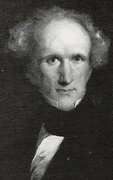People lined the streets in front of the Philadelphia Mint on May 25, 1857 so that they can trade their foreign coins for newly minted Flying Eagle small cents. The scene must have pleased Mint Director James Ross Snowden, whose push for the coinage law passed by congress on February 21, 1857 allowed him to drive out all foreign coins from circulation.
When Snowden became Mint Director in 1853, he was faced with the issue that the price of copper and the increasing labor costs were making the large cent uneconomical to make. Snowden also knew that for the nation to continue to thrive, the lower denomination foreign coins that were still being used in the United States had to be removed from the economy. Aside from the large cent not being popular with the public, Snowden also believed that the value of subsidiary coinage can be based on trusting the government as the issuing authority and not necessarily the intrinsic value of the metals used.
 Snowden tasked James B. Longacre with designing a smaller coin to replace the large cent. Longacre borrowed the Christian Gobrecht/Titian Peale design that was used on pattern dollars twenty years earlier to create a unique obverse. For the reverse, Longacre adapted the wreath he made for the 1854 one and three dollar gold coins. Snowden ordered 1,000 of these 1856 Flying Eagle Cents to struck in order to distribute to congress and other politicians as part of his lobbying effort to allow for their regular production.
Snowden tasked James B. Longacre with designing a smaller coin to replace the large cent. Longacre borrowed the Christian Gobrecht/Titian Peale design that was used on pattern dollars twenty years earlier to create a unique obverse. For the reverse, Longacre adapted the wreath he made for the 1854 one and three dollar gold coins. Snowden ordered 1,000 of these 1856 Flying Eagle Cents to struck in order to distribute to congress and other politicians as part of his lobbying effort to allow for their regular production.

 At least 634 of these pattern coins were distributed amongst official Washington. Although many of the politicians liked the coins, it did not produce immediate action. Snowden continued to lobby congress for the new coin and the demonetization of foreign coins circulating in the United States until the coinage law was passed.
At least 634 of these pattern coins were distributed amongst official Washington. Although many of the politicians liked the coins, it did not produce immediate action. Snowden continued to lobby congress for the new coin and the demonetization of foreign coins circulating in the United States until the coinage law was passed.
Without waiting for the bill to be singed by President Franklin Pierce, Snowden ordered news dies to be made and a large number of coins to be struck. Although the exact number ordered is lost to history, it is estimated that between two or three million Flying Eagle cents were struck.
On May 25, 1857, the Mint constructed temporary wooden teller windows to trade the new cents for subsidiary foreign coins that were demonetized by the new law. The new coins were a success and the Mint went on to strike over 42 million of these coins driving all demonetized foreign coinage out of the market.
Longacre’s design was difficult to strike because of the relief and the placement of the eagle over the reverse elements. So the Flying Eagle design lasted two years with attempts at a die change in 1858. Snowden changed the design in 1859 to the Indian Head cent claiming the relief was too high and the design was not accepted by the public. Although the explanation has been disputed, Snowden was successful with introducing a coin that was accepted by the public and driving out foreign coins—150 years ago today.
Longacre portrait courtesy of uspatterns.com

